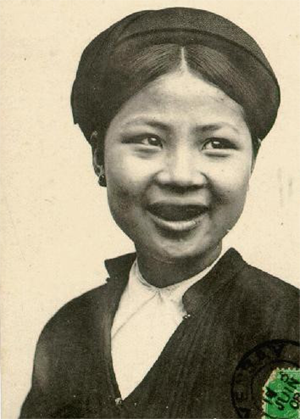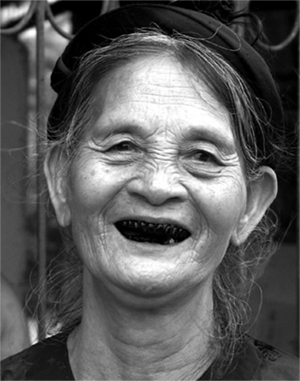Tooth blackening is one of the old customs of many ethnic groups in East Asia, such as Vietnam, Japan, Malaysia and Southern China. In Vietnam, besides the Kinh people, other people such as the Thái, the Si La, the Tày, and the Dao also maintain this practice.
 Tooth blackening is an ancient custom of the Vietnamese people, dating back to the period of the Hùng Kings (about 2,000 years BC). In addition to the custom of chewing betel nut, it has become a unique culture of the Vietnamese people. In order to obtain shiny black teeth, one needs to go through many elaborate dyeing processes aside from eating betel nuts.
Tooth blackening is an ancient custom of the Vietnamese people, dating back to the period of the Hùng Kings (about 2,000 years BC). In addition to the custom of chewing betel nut, it has become a unique culture of the Vietnamese people. In order to obtain shiny black teeth, one needs to go through many elaborate dyeing processes aside from eating betel nuts.
According to tradition, black teeth were the standard of beauty, not only for women but also for men. Black teeth are not only popular among ordinary people but also among nobles and royalty. The process of dyeing teeth black is only common in the Central and Northern regions, however. The imperial capital of Hue is considered to be the most prosperous place in the art of tooth blackening, because there lived his and her royal Highness, their court of eunuchs and concubines, and their little princes and princesses, little lords and ladies who were interested in dyeing their teeth.
There are special recipes for the dental dyes used by the ancient Vietnamese people: the powder of ant wings’ nectar, lemon juice, black alum, and the syrup of coconut shells. During the dyeing process, the person blackening their teeth must abstain from all kinds of things, including hot foods and hard foods, and they usually only eat soft foods such as porridge or vermicelli for a period ranging from12 days to half a month. When the teeth gain their black color, they can eat normally again.
However, even when teeth are already colored, they might fade over time. Therefore, people need to dye them again. Men dyed them once or twice, and women dyed them once a year so they would not have to do so again once they were over 30 years old.
The custom of dyeing teeth at that time was so popular, it became a career to make a living. In the past, in rural and urban areas, there were artisans who specialized in teeth blackening.
 Blackened teeth is just a memory to the young Vietnamese generation
Blackened teeth is just a memory to the young Vietnamese generationAt the end of the 19th century, although under French colonial occupation, the Vietnamese did not forfeit their pride of their blackened teeth. However, towards the 20th century, especially after the Great War, Vietnam faced drastic social transformations.
In the early years of the 20th century, many women followed the new trend of favoring white teeth; some even scraped away the black teeth they had spent so much time and effort to dye in order to become the new women participating in social reforms, such as women suffrages and the liberation of the country.
From 1945 till now, the tradition seems to have dissipated. Nowadays, people can only see woman at the age of from 70 and older with her teeth blackened. The image of a woman with a blackened set of teeth may have faded into obscurity. However, it remains a cultural magnificence in the Vietnamese culture.
This is one of the many things you may see on our Vietnam package tours. If you would like to receive a quotation for your tour, please contact us we will get back to you shortly.